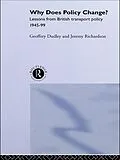The tension between policy stability and change is a key political phenomenon, but its dynamics have been little understood. Why Does Policy Change? examines and explains the dynamics of major policy change by looking at case studies from British Transport policy since 1945. The significant contrasts between road and rail policies in this period lend themselves perfectly to the authors' theories of what brings about policy turnabout.
Autorentext
Dr Geoffrey Dudley, Geoffrey Dudley, Jeremy Richardson
Inhalt
1. Government, interest groups and policy change 2. The dynamics of the rail 'hollow core': the prelude to Beeching 3. Occupying the 'hollow core': the Beeching era at British Rail 1960-65 4. Roadbuilding as a policy idea and a weak advocacy coalition 1900-54 5. Ministers and motorways: the making of a hegemonic policy community 1954-59 6. Undermining a hegemonis policy community: trunk roads and the first wave of environmentalsim 1973-79 7. 'Roads for prosperity' versus 'sustainable mobility': new challenges and confrontations 1989-93 8. The destruction of 'roads for prosperity': from hegemony to ignominy 1993-99 9. The 'hollow core' revisisted: rail privatisation 1987-92 10. Why does policy change? 'The four I's' and the significance of time
